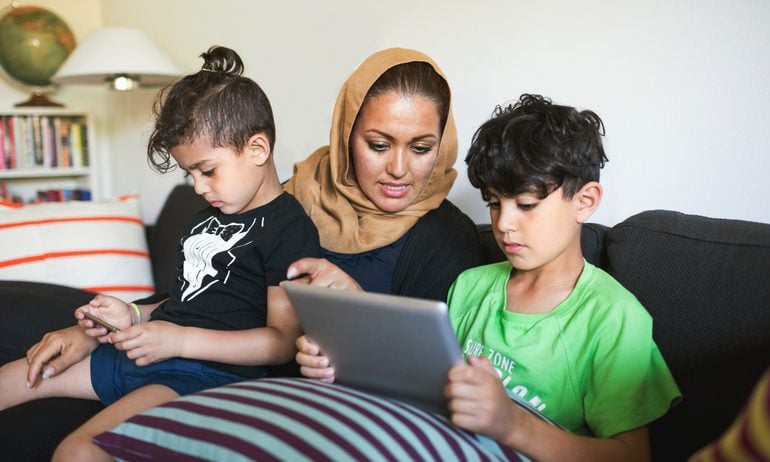10 Best Banking Apps and Debit Cards for Kids and Teens

Many, or all, of the products featured on this page are from our advertising partners who compensate us when you take certain actions on our website or click to take an action on their website. However, this does not influence our evaluations. Our opinions are our own. Here is a list of our partners and here's how we make money.
Parents or guardians who want to teach their kids about money have some trendy tools at their disposal: kid-focused banking apps, many of which come with debit cards. These apps can often replace kids or teen checking accounts since the apps offer federally insured spending accounts through partnerships with banks.
Kids can learn how to save and spend (with a parent supervising safe account use), and parents can easily give allowances on a schedule or, on some apps, once chores are complete. Teens can have more freedom and features, such as direct deposit and peer-to-peer transfers. And there’s no need to visit a bank branch.
Skip down to a specific app or category:
Best educational kid banking apps: Greenlight, Acorns Early (formerly GoHenry)
Best for kid banking on a desktop: FamZoo
Other apps to consider
Banks with kid-friendly checking accounts (and branches)
How kid and teen banking apps work
Today’s kid-friendly banking apps tend to have more customized tools and perks than traditional bank accounts do. These apps often have the following features:
App access for kids, teens and parents: Mobile banking, or app-based banking, is a common way to view balances and manage accounts. Some apps have a minimum age of 6 or 13, though some allow for any age, with a parent required for anyone under 18.
Link to a debit card: Kids can use a physical spending card that’s part of the Visa or Mastercard payment network for purchases or ATM withdrawals. Some apps have prepaid debit cards that let kids make card purchases or ATM withdrawals just like debit cards. For simplicity, we’ll refer to all non-credit spending cards as debit cards. One app links to a secured credit card that acts like a debit card for spending only what is available.
Federally insured accounts: All apps on the list partner with banks to offer accounts insured by the Federal Deposit Insurance Corp., which protects customer’s money in case the partner bank fails. (These apps are also known as fintech firms or neobanks.)
Allowances: This automatic transfer feature lets a parent decide when to send money to kids, such as on a weekly or monthly schedule or only when chores are checked off.
Chore management: A kids banking app can function as a household chore chart with the option to link to allowance pay.
Parental controls: Many apps allow parents to turn on or off kids’ debit cards, while some go further to let parents create custom spending limits or even block purchases from certain stores.
Co-parenting: Multiple parents can have similar account access to review transactions and pay their kids, though there’s often a primary parent account to activate a kid’s account. Not all apps have this feature.
Financial literacy content: Kids can learn about money through short, engaging formats such as educational videos, games or quizzes on some apps.
Savings goals: Kids can have multiple subaccounts, or account balances, for different things they’re saving for, with no extra cost or sign-up. Some apps provide a visual of savings as a mileage meter or completion wheel, and there can be a separate option to save for charitable causes. Savings rewards may be offered, even as a percentage of the account balance, but it’s not considered interest.
» Want your kid to earn interest? Consider the best kids savings accounts
Best educational kid banking apps
The saying “you get what you pay for” may ring true for parents looking for an app stacked with the most features for their kid or teen. Monthly fees vary, but the features — ranging from chores to savings buckets — tend to be similar.
Greenlight
Tools for chores and allowances.
Savings goal feature.
Robust parental controls.
In-app educational activities.
Highly rated app.
Monthly fee (for family plan).
No free ATM network.
Greenlight provides a strong mix of tools and financial literacy features for youth of any age. Each kid on a family plan can get a Mastercard debit card. The app lets parents create chore and job lists, provide allowances via online transfer to kids accounts and provide kids a way to save with buckets for spending, saving and donations. Allowances can be paid on a regular schedule as well as partial or no payment until chores are complete. Teens with jobs can set up direct deposit as well. Parental controls include turning cards on or off, real-time spending alerts and blocking unsafe spending categories.
Accounts don’t earn interest, but parents can give “parent-paid” interest. They set the rate and the child can see how the interest compounds, or earns more interest, over time. The app also has educational games to teach kids about money. (Note: Greenlight has a secured credit card, but it has a waitlist.)
Fees: The basic family plan costs $5.99 per month. Adding investing, cash back rewards, and customized security features such as family location sharing costs extra. There are no ATM fees charged by Greenlight, but ATM operators may charge.
Minimum age: None.
Number of kid accounts per plan: Five accounts.
Acorns Early (formerly GoHenry)
Tools for chores and allowances.
Savings goal feature.
Robust parental controls.
In-app educational activities.
Highly rated app.
Monthly fee (for family plan).
No free ATM network.
Acorns Early (formerly GoHenry) is the kid-friendly app owned by microinvesting fintech firm Acorns. Designed for ages 6 through 18, the app provides allowance and chore management alongside a debit card. Kids can play in-app games called “money missions” to learn about money. Teens can send money to friends on the app and receive paychecks via direct deposit.
Parents can see real-time notifications, create spending limits and turn off access to lost or stolen cards. Family members can send money to kids through Acorns Early’s Giftlinks feature, which works like an electronic gift card. Kids can receive parent-paid interest and save for separate goals.
Fees: A family plan costs $10 per month. The other pricing option is $5 per month per child. Acorns Early doesn't charge for ATM withdrawals, but ATM operator fees may apply.
Minimum age: 6.
Number of kid accounts per plan: Four accounts.
Best free kid banking apps
If cost is more important than features, there are apps without monthly or annual subscription fees that offer strong digital banking experiences for kids, teens and parents. They usually don’t have as many financial literacy lessons or games included, but there can be different experiences for kids under 13 compared to teens using these apps.
Note that free apps can still have fees, such as for inactivity or for more perks, but the apps don’t require fees to use, similar to free checking accounts for adults.
Till
No monthly fees.
Tools for chores and allowances.
Savings goal feature.
Highly rated app.
No free ATM network.
No custom parental controls for spending.
Limited in-app educational activities.
Kids debit card, spending insights, task lists, savings goals, parent wallet are all included in Till’s offering. The app has different types of parent or adult roles, such as account owner, admin (for a second parent) and community members who can contribute to kids’ savings.
Unlike some apps, allowances are limited to a weekly or monthly cadence instead of more customized schedules (though payments can be paused or skipped). Parents can also assign chores and set up payments that are paid once the chores are completed. They can monitor spending and lock a lost or stolen card or a kid’s balance, but creating custom spending or withdrawal limits or having two parents with equal account access aren’t available.
Through Till's "Give Link" feature, acquaintances can make deposits directly to a child's debit card. Parents can also help children set savings goals and add to them in the form of deposit matches, fixed contributions or monthly percentage bonuses.
Till has educational blog content about money lessons, in addition to other channels, but not short-form formats, such as kid-friendly games or quizzes, within the app.
Till offers its banking experience for free. A premium version is available for a fee, with a maximum of five kids per plan. It includes everything in the free plan plus cash back, savings rewards and other perks.
Fees: None. Till doesn’t have ATM fees, but ATM operators may charge a fee. The premium plan costs $6.99 when paying monthly, but it’s slightly cheaper to pay annually.
Minimum age: 1.
Number of kid accounts per plan: No limit on free plan.
Step
Ability to build credit.
No monthly fees (for standard plan).
Free ATM network.
Tools for allowances.
Savings goal feature.
Highly rated app.
No chore management.
Step stands out for offering a secured credit card instead of a debit card. Kids can build credit over time without spending more than their balance. Savings goals are available, plus rewards that can act like interest. Teens can set up direct deposits from jobs. But Step isn’t for chore charts or paying allowances based on chores.
Step has financial literacy blog articles and courses in partnership with various U.S. high schools, well as some in-app financial trivia and videos. Parents can check kids’ spending, block merchants, and turn the credit card on or off, but account limits are determined by the app. The free app provides most features, but there’s also a premium service for teens to have more perks such as more cash back rewards and shopping discounts or credits.
Fees: There’s no monthly fee. Step customers can use VISA Plus Alliance ATMs for free. Using an out-of-network ATM costs $3. And funding with a debit card can cost up to 3% of the sent amount, but transfers from a bank account are free. A premium service for teens is available for $4.99 a month (or for free with a qualifying direct deposit of at lest $500 per month).
Minimum age: None.
Number of accounts per plan: Five accounts total for parents and kids.
Revolut
No monthly fees (for standard plan).
Free ATM network.
Tools for allowances and chores.
Savings goal feature.
Robust parental controls.
Highly rated app.
Limited in-app educational activities.
Known for its international transfers and multicurrency account, Revolut’s youth banking account Revolut <18 can be for kids as young as 6, though there’s no educational content for kids, such as in-app quizzes or games, within the app currently. The app has different ranges of tools for kids and teens. For example, only teens 13 and up can send money to and receive money from friends with Revolut <18. Youth accounts can only be for one currency.
Available features include saving for goals, creating money-earning challenges, getting allowances, and parental controls for real-time payment alerts and for locking lost or stolen cards. A secondary parent can be added as a co-parent.
Fees: Basic plan is free. Premium and Metal plans range from $9.99 to $16.99, though they focus on travel perks for adult accounts. Revolut and Revolut <18 customers have access to Allpoint ATMs for free.
Minimum age: 6.
Number of kid accounts per plan: Five accounts.
Modak
No monthly fees.
Tools for allowances and chores.
Savings goal feature.
In-app educational activities.
No ATM access.
Modak is another strong offering with no monthly fee. It’s an app and debit card that lets parents set allowances and chores. Kids can earn money by completing chores assigned by parents, and have the option to create chores themselves, which parents can review before awarding payment. Parents can also create unassigned chores, so whichever kid on the plan completes the task can earn payment. Kids can create and manage their own savings goals, which they and their parents can contribute to. Modak’s in-app educational activities include games and challenges that let kids earn rewards that can be converted to cash in their accounts.
The main downside is that ATM access is unavailable (though the company plans to offer access in the future).
Fees: No monthly subscription fees. No fee to fund kids’ accounts from a bank account, but it costs $0.50 to fund from a debit card plus an additional 3% to fund through Apple Pay or Google Pay.
Minimum age: None.
Number of kid accounts per plan: Seven accounts.
Current
No monthly fees.
Free ATM network.
Tools for allowances and chores.
Robust parental controls.
Highly rated app.
Inactivity and closure fees.
Limited savings feature.
No in-app educational activities.
Current’s teen account has a mix of tools such as allowance transfer and chore lists, coupled with parental controls with custom spending limits. Two parents can fund the teen’s account, and the account is free to set up and use.
The main downside is the savings component. Teens can use one savings pod and a pod for donations, but the pods’ names can’t be edited to customize for a specific goal. The teen account doesn’t have any games or quizzes for financial literacy.
Fees: No monthly subscription fees. Going a year without account usage triggers an inactivity fee of $5 per month. Closing an account costs $10. Current provides free access to a nationwide ATM network, Allpoint, but charges $2.50 per ATM withdrawal at non-Allpoint ATMs.
Minimum age: None.
Number of teen accounts per plan: Five accounts.
Best for kid banking on a desktop
For families who want to bank without relying on smartphones, one option provides more access channels.
FamZoo
Works on desktop and mobile browsers and via text banking.
Tools for allowances and chores.
Savings goal feature.
Robust parental controls.
Monthly fee.
No free ATM network.
FamZoo has a unique feature among the apps on our list: No smartphone is required for kids or adults. FamZoo works on web browsers on desktop computers and mobile devices and has an option for text banking. It has mobile apps as well.
This platform can come with a prepaid debit card that lets parents monitor account activity and track balances. It also has an option to create a virtual “IOU” account. With this alternative, the parent or child manually enters transactions for funds held elsewhere — such as cash in a piggy bank. Or they can simply manage virtual IOU money in the app or on the website, which might be a good choice for younger kids who aren’t yet ready to handle real currency. FamZoo lets parents set up chore lists, allowances on a schedule and send parent-paid interest to kids. Kids can save funds in separate subaccounts.
Fees: A FamZoo subscription is $5.99 a month, with discounted plans if parents prepay. The price is the same whether the family chooses prepaid debit cards, IOU accounts or both. There’s no free access to an ATM network, but FamZoo doesn’t charge ATM fees.
Minimum age: None.
Number of kid accounts or cards per plan: Four cards (but more are available for a fee).
Other apps to consider
Here are two apps that didn’t make our main list but are popular peer-to-peer apps with teen-friendly accounts:
Cash App for teens (sponsored account): Cash App lets parents invite teens 13 and up to the app to take advantage of peer-to-peer transfers, allowance transfers, savings goals and a debit card. There’s no monthly fee, but also no free ATM network (unless you meet a direct deposit requirement) and no ability to customize a chore list in the app.
Venmo (teen account): Venmo lets parents give teens 13 and up a debit card and optional access to a Venmo account for peer-to-peer transfers. There’s no monthly fee and Venmo gives access to a free ATM network, but the app lacks family-friendly budgeting tools or savings goal features.
Banks with kid-friendly checking accounts
If you’d rather stick with a more traditional bank that has branches, consider these options tailored to both teens and kids starting at an early age.
Capital One MONEY Teen Checking account: Kids ages 8 and up can open this interest-earning online checking account with their parents, and parents don’t need to have an account at Capital One. There are no monthly fees or minimums. Kids can visit Capital One locations (mostly in a handful of states) and many fee-free ATMs nationwide. There are parental controls, allowance tranfers and savings goals.
Chase First Banking and Chase High School Checking: The biggest U.S. bank (by assets) separates its kid-friendly offerings into Chase First Banking designed for kids ages 6 to 12 (available up to age 17) and Chase High School Checking for students ages 13 to 17. Parents must be Chase customers to open these joint accounts. Kids up to 17 years old don’t pay monthly fees. A debit card is available for both accounts. Chase First Banking has spending controls, savings goals, allowance and chore features, but the high school account doesn’t. Mobile banking features are mostly reserved for teens.
» COMPARE: See our list of best teen checking accounts and best college checking accounts
Methodology for kid and teen banking apps
We analyzed 15 kid- and teen-friendly banking apps linked to a debit card or prepaid debit card (and secured credit cards). The apps, offered by fintech firms in partnership with banks, have federally insured accounts for kids and/or teens.
We considered fees and a range of features, including chore or task management tools, allowance transfers, savings goals, parental controls, financial literacy content (usually short videos, games or quizzes) and the ability to withdraw cash at ATMs. Parental controls can include custom spending limits, co-parenting settings and the ability to turn a kid’s debit card on or off. We looked at app ratings on Apple’s iOS app store and Google’s Android store as well.
Apps considered include: BusyKid, Cash App, Current, FamZoo, Goalsetter, Acorns Early (formerly GoHenry), Greenlight, Jassby, Mazoola, Modak, Revolut, Step, Till and Venmo.
ON THIS PAGE
ON THIS PAGE









